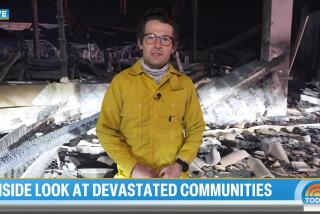L.A. and the ‘Big One’: TV Ready . . . and Waiting
- Share via
KNBC Channel 4 news director Tom Capra promised Wednesday that when the “Big One” hits Los Angeles, his station will not suffer the same fate the befell his sister station KRON in San Francisco, which was completely knocked off the air by Tuesday’s violent quake and was unable to resume its full broadcast services for nearly two hours.
Several other local stations contacted Wednesday also confirmed that they have taken precautionary measures to insure that they will be able to beam live pictures and information to viewers in Southern California and around the country in the wake of a massive local earthquake.
“We know that what happened to KRON (which was not equipped with any emergency power) can happen here, and we are prepared for that,” Capra said. “In the 1971 Sylmar quake, we were knocked off the air and so we have provided for emergency power. We have two sets of generators, and we can go three days without any outside assistance.”
Jeff Wald, news director at KTLA Channel 5, said that his station is equally equipped with back up generators to keep the studio lights and transmitting power functioning. And unlike most remote trucks, which run on gasoline powered generators, the remote capabilities on Channel 5’s trucks run on batteries that can keep the station on the air, if all else fails, for at least 11 hours.
Channel 2 news director Michael Singer said that his station has similar emergency plans, and in the next few weeks would be evaluating what happened to the stations in the Bay Area on Tuesday to determine what additional measures might be needed here.
When the quake hit Tuesday, Channel 4’s Capra said, people in Los Angeles probably knew more about was going on in San Francisco than people living in downtown San Francisco because of widespread power outages there that rendered television sets useless. The San Francisco television stations that were able to stay on the air, however, provided a first hand look at what the quake had wrought on the Bay Area for viewers here in Los Angeles.
Within half an hour after the temblor struck, Channel 2 in Los Angeles was showing its viewers the coverage of its sister station KPIX in San Francisco. “The story was in San Francisco,” Singer said. “We didn’t have a reporter up there, so we thought it would be best to go to our affiliate. News and information and pictures were pouring out of there and we thought we should get on the air with it.”
Channel 4 got burned during the first hour of the quake because KRON was knocked completely off the air and could not provide the NBC stations around the country with live pictures. Even when the station finally did scrounge up enough power to broadcast something, all it could show was its two anchors standing in a dimly lit hallway talking about what had happened. Before KRON got back on the air, KNBC used photos and commentary supplied by the NBC affiliate in Sacramento.
Meanwhile, KPIX, the CBS affiliate was on the air using back up generators to power their broadcast, and all the ABC affiliates, including KABC Channel 7, “lucked out,” their competitors said Wednesday, because the network had “tons of equipment” and personnel on hand to cover the World Series.
“What you wouldn’t give to have a blimp in the air when a bridge falls down,” Capra said. ABC lucked out.”
KABC news director Roger Bell did not return phone calls from the Times Wednesday, but his station, both Wald and Capra said, provided the best early coverage of the quake, supplementing Ted Koppel’s and Al Michael’s network coverage with use of the ABC San Francisco affiliate’s pictures and anchor team and discussions of the events between their own reporters in studio here in Los Angeles. The station also pressed sports reporter Rick Lozano, who was at Candlestick Park to cover the World Series, into duty as a news reporter.
Fox Broadcasting’s KTTV Channel 11 was the only independent station to provide extensive coverage of the San Francisco earthquake throughout the evening, tapping frequently into CNN’s coverage.
All the local stations immediately dispatched their own reporters to the Bay Area. KTLA’s Stan Chambers drove in the station’s mobile satellite truck and provided a live report on the 10 p.m. broadcast from Coalinga--where he interviewed people there who had felt the quake.
Both Channel 2 and 4 flew reporters into San Jose. Channel 4 also rented a satellite truck here in Los Angeles and drove it up to Santa Cruz with reporter Phil Shuman aboard for late night live reports from that beleaguered city.
More to Read
Sign up for Essential California
The most important California stories and recommendations in your inbox every morning.
You may occasionally receive promotional content from the Los Angeles Times.













